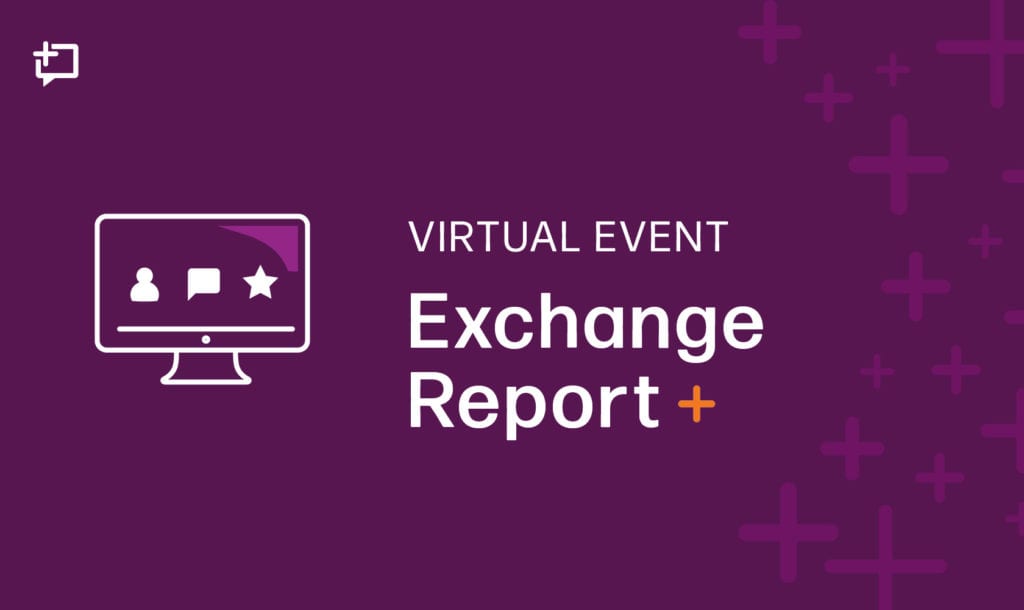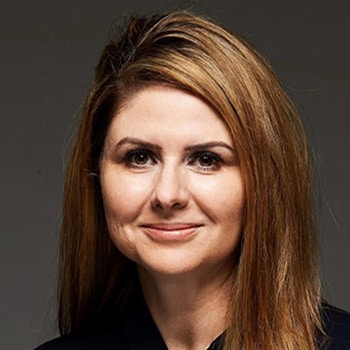Leveraging Virtual Reality to Sell

Lauren: Tamara Adams is the VP of global sales service and marketing at Honeywell Connected business. Her company provides enterprise software solutions to the commercial hospitality, healthcare, retail, travel, education – pretty much any industry you can think of. And in her current role Tamara is focused on transforming the direct sales channel into a world-class sales organization. And she’s really increasing their focus on enterprise SaaS-based selling, and growing and developing the partner and professional services strategy. So I’m really interested in hearing about this.
She joined Honeywell about two years ago, following a really impressive career at Perkin Elmer, metadata, and then Oracle – a very long time at Oracle – and she’s a globally recognized sales leader who focuses on helping organizations solve their most complex problems.
So I know that she did start her most recent role right before the pandemic hit – I was looking at the timing – so I’m going to be sitting on the edge of my seat to hear some of her pearls of wisdom on how she’s led through this time of enormous uncertainty and change.
So without further ado, Tamara, take the stage, please.
Tamara: All right. Thank you so much. Kim’s a hard act to follow. I love the passion and the energy. I was really fired up. It was awesome.
So, yeah, as [Lauren? 00:01:30] mentioned, I started right before the pandemic hit, which we are actually deploying and implementing some brand-new software. So Honeywell, you think of Honeywell, you think of thermostat, you think of filtration systems, you think of maybe aerospace and defence, but really we are a organization – Honeywell Connected Enterprise has really been formed to really transform kind of a industrial sector into a technology sector, and we’re really looking to sell software. Right?
And so if you’ve read anything about Honeywell in the last probably two weeks, you saw that we’ve moved over into the NASDAQ stock exchange. So, really, our CEO really believes the fact that we are going to be transformational and really do that digital transformation, and we are going to do a say-do, if you will, and really driving that through greater margin and opportunity through software-type sales.
And so, yeah, I started right before the pandemic, and then we were deploying these software and technologies, and I was ramping up a brand new team and creating a brand new organization. And then we got a little bit side-swiped by all of these events that have impacted all of us. And so one of the things I wanted to talk a little bit about today is, like, how do you take and harness your team and really kind of stay ahead of the competition? We’re virtual, right? And so how many webinars are – have we all been invited to, to be sold to, and it’s a little bit repetitive, right? And so how do you try to differentiate yourself in the marketplace with a brand-new product, very limited install base, and how do you get that compelling the message across?
PowerPoint can be really hard to do—right?—and some light demonstrations of the software, but how do you really immerse your client base and your prospect base into kind of what you’re trying to convey in your messaging, and really going to level up? And so to stay ahead of kind of the competition and really get our messaging out there, I really believe that we should be demonstrating the software in a new way.
And so in a real sense the pandemic forced me to accelerate the virtual selling model, and it raised some really big concerns in kind of how our clients are kind of facing this face-to-face connections, right? Because that personal connection and things that Kim talked about before are really, I think, important and core to building your relationship and your mindset with your clients, right?
And so I had to answer the following question. Like, how do I bring that kind of immersive experience to our customer and prospect base, and how do I get – how can I use this technology knowing that we’re still not going to be together for the next six to, I don’t know, you know, 12 to 14 months?
And so to answer this question I really turned to virtual reality, and so my vision was really to kind of walk our clients into a virtual building. Think of it like a video game. So, on your laptop, and where we can walk you into the building. I can actually show you the software and how it would interact with you in the building, how to check you in, look at virtual aspects of it, and so kind of walking through a day in the life, if you will, and using the software and different Honeywell technologies and bringing that all together. And so really enhancing, kind of, if you will, kind of the CXO experience through virtual reality.
And so in this consultative type of approach that we took, we were actually trying to demonstrate how to run your facility from anywhere? So think about kind of how we’ve all been working remote. Those buildings that we’re selling into still have to operate, even though there’s nobody in them. We still have to maintain security; we can still maintain kind of fire suppression equipment; we still have to maintain occupant experiences for those who actually have to go back into the building. And we need to be able to kind of run that from anywhere in a kind of a single-dashboard or a single pane of glass, if you will.
And to make it into the kind of the current environment we need to really kind of show those owners and occupiers and those executives, and think about all the industries that have buildings: hospitality, you know, your airlines, your airports, your retailers. All of those have to be able to run them within the building itself, actually run them remote from your Home Office, or even your coffee shop.
And so I would tell you that it’s been a journey. And some of the real challenges that we really looked at have been kind of obvious. We didn’t anticipate some of the rigour in the journeys that we had to kind of contemplate and to create that virtual reality and that kind of 3D environment. And so we needed to think about all the personas that we had to kind of pull forward. But the cool thing that we are actually doing now is it’s really resonating well with our clients, and our clients are saying, oh my gosh, it’s – you’ve brought me back into my office or back into my building. And we’ve actually created very custom personas: everything from an airport to a retailer, whether it looks and feels kind of like a best buy or a Wal-Mart or a Target – kind of thinking about your favourite retailer – as well as your traditional kind of office building, whether it could be kind of a banking institution in New York City, or maybe it’s a, you know, kind of a technology facility you would see on kind of the west coast out in Silicon Valley.
So in order to kind of deliver that whole day-in-the-life experience, we had to kind of step through each one of those elements of that journey, and the feedback has been tremendous. And so our clients are now saying, like, look, you’ve really kind of proven your viability of your product by really kind of connecting my business problem, as well as kind of helping us drive an ROI TCO model – all virtually, because we’re still not meeting in person yet, right? And so we had to be able to take every business case possible from the facility leader all the way to kind of the board room and the CXO’s office. And so those proof points are things that we’re really contemplating now as kind of now this virtual reality piece.
And so we had to kind of establish an overall thesis and we kind of had to prove out those KPIs, and how to measure, really, in essence, those sales cycles by using a virtual reality concept. And so our thesis is really to kind of take and shorten the sales cycles, really, kind of from 135 days, down to kind of 65 days by bringing in this virtual reality segment.
And so we’re in the process of right now kind of rolling out that overall kind of KPI and measurement. And then also we’re kind of thinking about the overall sales cycle; we’re also thinking about can we start conducting actual pilots, using kind of this virtual reality concept and even shrinking those sales cycles as well?
And so if, you know, if you’re – unless you’re a gamer, you know, there’s a lot of what I’m talking about that won’t be native to kind of all executives that we – and managers that maybe we connect with, but I’m really estimating kind of in this virtual environment that we’re in today and some of the technologies that we’ve had to adopt kind of over this kind of 12- to 14-month journey, we’re going to see probably an uptick of about 75% of adoption and customers that, actually, it really will resonate with. And so far we’ve seen actually 100% uptake in adoption, which is fantastic. But we estimate at least about 75% of that customer base that we’re kind of reaching out to.
And so if you kind of think about how we’re designing this, it’s everything from kind of a cityscape and then kind of zooming into kind of your building and then really kind of navigating to kind of all your kind of customer scenarios that we can potentially identify.
And so I don’t think we’re going to go back to the, you know, kind of the thesis that I’ve come away from all this is and some of the solution we’re thinking about, is I don’t think we’re going to go back to the old world of selling anytime soon. I think maybe many companies are thinking about and contemplating this direction, thinking about, too, if you’ve got kids that are actually on their way to college and trying to, you know, do some scouting of those colleges. They’re having to do a lot of that stuff virtually, right? And those tours are becoming increasingly important through virtual reality.
So I think we’re going to start to see a lot of mainstream adoption, and we’re not going to go back to kind of some of the old ways.
And, you know, I think this experience is really going to take, you know, really going to show us, anticipate the customer readiness for this type of experience, like I said, at least upwards of 75%.
So I’m super pumped that my team has been really adopting this and transforming kind of how they sell, and I anticipate this is also going to kind of help us, you know, with some of those operating expenses and travel expenses kind of in the future as well.
So, super pumped that we’re kind of heading down this path, but kind of wanted to share with you a little bit about kind of the virtual reality selling aspect of it, and how we’re really kind of making a true digital transformation here within Honeywell.
Note: The following text is transcribed from the event audio. It’s largely accurate, but in some cases it may be a bit off due to inaudible passages or transcription errors. It’s intended as an aid to understanding the event, but it shouldn’t be treated as an authoritative record.





